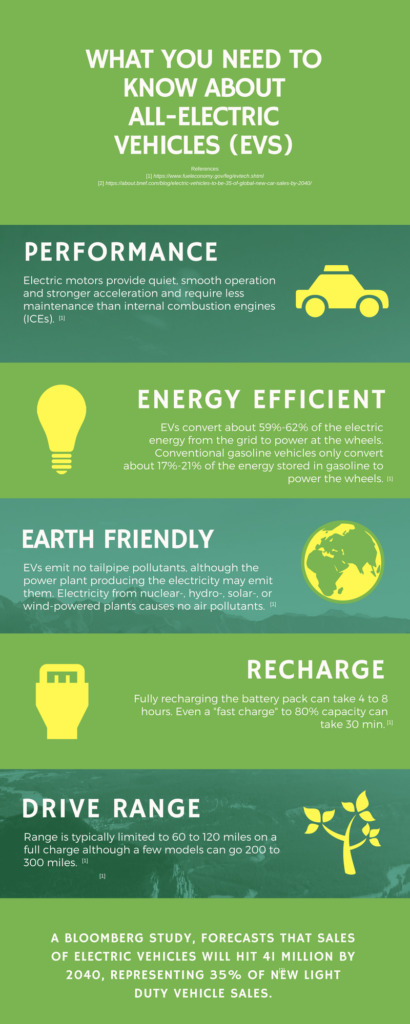
Customers and automobiles have changed since convenience stores first existed. As the need changes, convenience stores need to change as well. The same is going to be true as all-electric vehicles (EVs) become more and more popular.
What are Electric Vehicles?
According to ENERGY.GOV, “there are two basic types of EVs: all-electric vehicles (AEVs) and plug-in hybrid electric vehicles (PHEVs). In addition to charging from the electrical grid, both types are charged in part by regenerative braking, which generates electricity from some of the energy normally lost when braking.”
“EVs’ major feature is that drivers can plug them in to charge from an off-board electric power source. This distinguishes them from hybrid electric vehicles, which supplement an internal combustion engine with battery power but cannot be plugged in.”
The Chevy Spark and Kia Soul EV are EVs while the Chevy Volt and the BMW i3 are PHEVs.
What You Need To Know
Check out this infographic for a quick run down of ‘what you need to know’ about electric vehicles.

Convenience Store Charging
Convenience stores have evolved from gas-pumping stations and now offer extensive offerings to their customers inside the store. However, they do still sell fuel and the industry needs to be thinking about the future of electric vehicles and how their increased existence is going to change the way customers travel and shop.
According to fueleconomy.gov, there are three basic types of charging:
Level 1: 120 volt outlet offers about 5 miles of range per hour of charging
Level 2: 240 volt outlet is 2-5 times faster than a Level 1 charger
Level 3: also known as DC fast charging or DC quick charging allows about 50-70 miles of range to the battery in 20 minutes.
Level 1 and Level 2 options are available to EV drivers at home, however, Level 3 charging requires special equipment not available for consumer-level purchase. This means that for faster charging in a pinch–or on longer trips–consumers are going to be looking for Level 3 charging facilities on the road.
Convenience stores are intended to offer ‘convenient’ solutions for their customers. While the quick ‘grab-and-go’ options are what pulls in many customers, would it be worth-while to convert parking spaces over to Level 3 charging stations that will be occupied for up to 20 minutes? It’s definitely a tactic worth considering as EVs continue to become more and more mainstream.
For further reading and inspiration on how other retailers are handling charging stations, check out CSP Daily News’s piece 4 Retailers Charging Up. Also, CStoreDecisions.com reports that “Tesla Motors is looking to partner with Sheetz and expand its network of vehicle charging stations to more Sheetz locations.”
Has your location begun investing in electric vehicle charging stations? Let us know about your successes and pain points in the comments below.









Leave a Reply